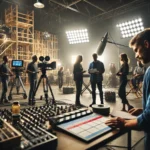Film and television acting differs significantly from stage acting. While stage actors need to project their voices and movements to reach the audience, on-camera acting demands subtlety and precision. For aspiring actors, mastering the techniques for acting in front of the camera is essential for delivering authentic and engaging performances. Here, we break down the core skills you need to succeed in this realm.
Understand the Medium
Before stepping onto a film set, it’s crucial to understand the differences between film and stage acting. Acting for the camera often requires smaller, more natural movements compared to stage acting.
Key Considerations:
- Facial Expressions: The camera captures every small detail, so exaggerated expressions aren’t necessary.
- Voice Modulation: While stage actors project their voice, film actors rely on more natural, conversational tones. Your voice should match the setting and mood of the scene.
- Physicality: Minimize large gestures and instead focus on precise, controlled movements that appear more realistic on screen.
Embrace Subtlety
One of the key differences between acting for the stage and the camera is the level of subtlety required. In film, less is more. The camera is incredibly intimate and will capture even the smallest changes in facial expressions or body language.
Practical Tips:
- Practice speaking at a lower volume while maintaining emotional depth.
- Focus on nuanced expressions to communicate emotions effectively.
- Be aware of how minor shifts in your body can communicate feelings and intentions to the audience.
Focus on Eye Contact
Your eyes are a powerful tool when acting for the camera. The slightest movement or gaze can tell the audience a lot about your character’s thoughts and emotions. It’s vital to use your eyes strategically, both when looking directly into the camera and when interacting with scene partners.
Best Practices:
- Avoid staring directly at the camera unless the scene calls for it.
- Use eye contact to establish a connection with your co-actors and to reflect the inner world of your character.
- Understand “camera angles” and how to position yourself so your eyes are effectively captured by the lens.
Hit Your Marks
In film acting, blocking and hitting marks are essential. Directors and cinematographers have set precise marks where actors need to stand to ensure optimal framing and lighting. Missing your mark can disrupt the scene or result in technical issues.
How to Practice:
- Get comfortable with hitting specific marks while staying in character.
- Rehearse blocking movements to internalize them so they feel natural during the performance.
- Stay mindful of the camera’s position and adjust your movements accordingly.
Maintain Continuity
Continuity is crucial in film acting, where scenes are often shot out of sequence. As an actor, you must maintain consistency in your performance across multiple takes or filming days.
Continuity Challenges:
- Remember details about how you moved, your facial expressions, and even your tone of voice.
- Pay attention to the emotional state of your character during each take.
- Collaborate closely with the director and continuity supervisor to ensure accuracy.
Take Direction Well
Directors are your guide on set, and being adaptable is key for any actor. On-camera acting often involves several takes with adjustments to the tone, timing, or delivery.
How to Respond to Direction:
- Stay flexible and open to feedback from the director.
- Adjust your performance without losing authenticity.
- Maintain a professional attitude and trust the director’s vision for the scene.
Control Nerves
Acting on camera can be intimidating, especially for newcomers. Nervous energy can translate poorly on screen, appearing as stiffness or awkwardness. Learning to control your anxiety is critical to delivering a natural performance.
Techniques to Calm Nerves:
- Practice relaxation exercises like deep breathing before your scenes.
- Focus on being present in the moment rather than worrying about the audience or camera.
- Rehearse extensively so you feel prepared and confident on set.
Understand the Camera’s Role
The camera is your partner in the scene. It’s essential to understand how different lenses and angles will affect the perception of your performance.
Tips for Working with the Camera:
- Learn about different camera shots (close-ups, wide shots, etc.) and how they influence your acting choices.
- Know how lighting can affect the mood and look of a scene.
- Use the camera to enhance your performance, rather than being intimidated by its presence.
Conclusion
Mastering on-camera acting is a journey of understanding subtlety, precision, and technicality. By honing these techniques and embracing the unique demands of acting for the camera, aspiring actors can significantly improve their performances and stand out in the competitive film industry. Remember that practice, preparation, and adaptability are key to delivering authentic, memorable on-screen performances.


